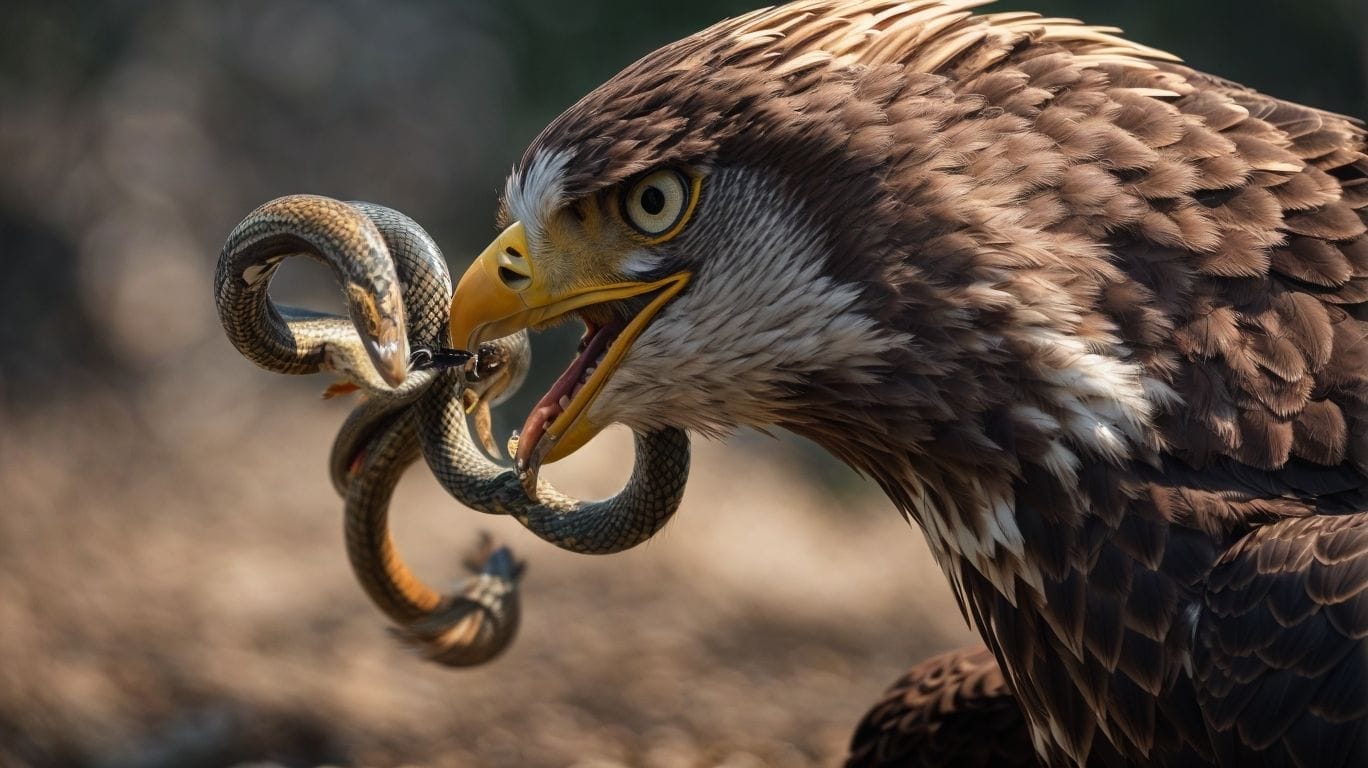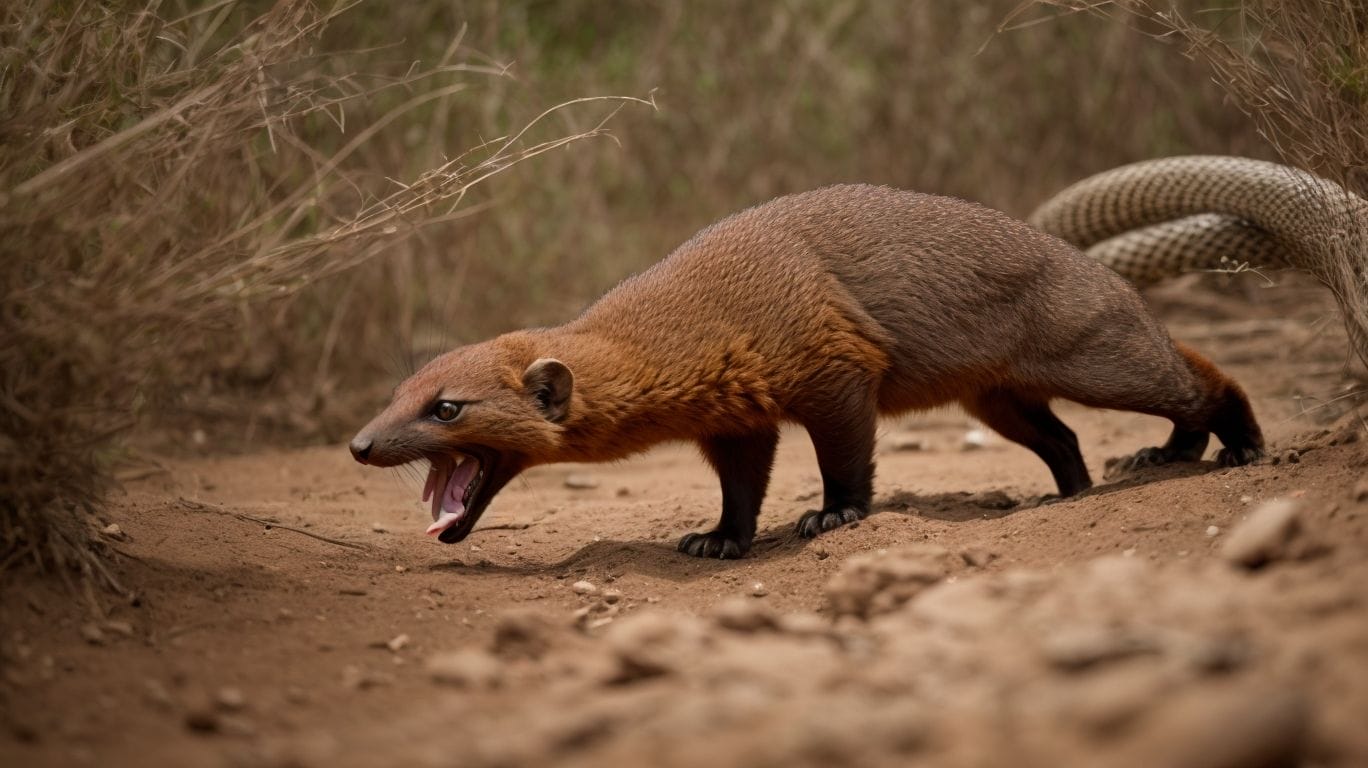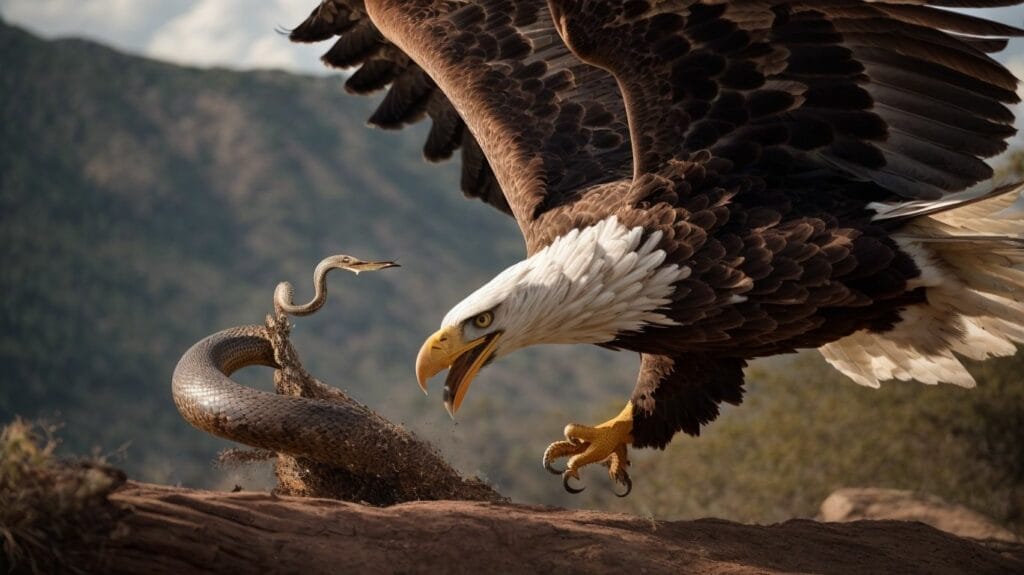Snake predation is a fascinating aspect of the animal kingdom, with various animals having developed unique adaptations to feed on these slithering creatures. Throughout the animal kingdom, there are mammals, birds, reptiles, amphibians, and other creatures that consume snakes as part of their diet. Understanding these predator-prey relationships can shed light on the intricate dynamics of wildlife interactions. Some notable predators include mammals like the mongoose, birds like hawks, reptiles such as kingsnakes, and even raccoons. Adaptations that help facilitate successful predation on snakes can range from physical characteristics like specialized teeth or constriction abilities to behavioral traits like stealth and ambush tactics. Examining the common examples of animals that eat snakes provides insights into the diverse strategies employed by these predators. By delving into the world of snake predators, we can gain a greater appreciation for the intricacies of nature’s food chain.
Key takeaway:
- Many animals prey on snakes: Mongoose, hawks, rattlesnakes, kingsnakes, raccoons, herons/egrets, and more all consume snakes as part of their diet.
- Adaptations play a role: Predators that consume snakes have both physical and behavioral adaptations that help them successfully catch and consume their prey.
- A complex relationship: The prey-predator relationship between animals that eat snakes and snakes themselves is an important aspect of the ecosystem, contributing to the overall balance of nature.
Snake Predation in the Animal Kingdom

Photo Credits: Petnarnia.Com by Dennis Davis
In the vast realm of the animal kingdom, snake predation takes various forms. From mammals to birds, reptiles to amphibians, and even other creatures, a wide array of animals have developed unique feeding habits, mercilessly consuming these slithering serpents. Journey with us as we uncover the fascinating world of snake predation, exploring the mammalian predators, the avian foes, the reptilian devourers, the amphibian hunters, and other surprising species that have made snakes a part of their diet. Prepare to be awestruck by the intricate web of nature’s hunters and the cunning ways they feast on these elusive creatures.
Mammals that Prey on Snakes
- Mammals that Prey on Snakes play a crucial role in controlling snake populations and maintaining ecological balance. Some examples of these mammalian snake predators include the mongoose, raccoon, and certain species of wild cats.
- Here is a list of Mammals that Prey on Snakes:
| Mongoose | Raccoon | Wild cats (such as bobcats and cougars) | Opossums | Mustelids (such as weasels and ferrets) |
- These mammals that prey on snakes have developed various adaptations, such as sharp teeth, agility, and resistance to snake venom, which enable them to hunt and consume snakes successfully successfully. Having these predator species in an ecosystem helps maintain a balance by controlling snake populations and avoiding overpopulation.
Birds that Feed on Snakes
Birds that Feed on Snakes are known to be predators that play a crucial role in maintaining the balance of ecosystems. Some species of birds have adapted specialized techniques and physical attributes to capture and consume snakes.
- Hawks: These birds of prey use their sharp talons and beaks to snatch and kill snakes from the ground or while in mid-air.
- Eagles: With their powerful wingspan and strong talons, eagles are capable of capturing and carrying off even larger snake species.
- Herons: Known for their graceful wading behavior, herons use their long bills and necks to impale and swallow snakes found in marshy habitats.
- Kingfishers: These agile and skilled hunters dive into water bodies to catch small snakes and other aquatic prey.
- Kookaburras: Found primarily in Australia, these birds have a robust beak that allows them to eat small to medium-sized snakes.
When dealing with snakes, these Birds that Feed on Snakes showcase their unique hunting strategies and play an essential role in the overall biodiversity of their habitats.
Reptiles that Consume Snakes
- Reptiles that Consume Snakes: Reptiles, such as the King Cobra, Reticulated Python, Eastern Indigo Snake, Coachwhip Snake, and Garter Snake, are known to be natural predators of snakes. They play a vital role in controlling snake populations in various ecosystems.
Considering the natural tendency of these reptiles to consume snakes, incorporating them into your environment can help control snake populations without the need for harmful chemicals or interventions.
Amphibians that Predate on Snakes
Amphibians that predate on snakes are a diverse group of animals that include predators who feed on snakes. These amphibians have special adaptations that allow them to capture and consume snakes successfully successfully. Some examples of amphibians that predate snakes include:
| – | Water snakes: | Certain species of water snakes, such as the water moccasin, are known to prey on smaller snakes. |
| – | African bullfrogs: | These large amphibians have been observed consuming small snakes as part of their diet. |
| – | Fire-bellied toads: | While primarily feeding on insects, these brightly colored amphibians have been known to eat small snakes as well. |
| – | Giant salamanders: | In some regions, giant salamanders have been documented consuming small snakes as part of their diet. |
| – | Newts: | Some species of newts, such as the rough-skinned newt, consume small snakes as part of their varied diet. |
In a remote wetland, a researcher discovered a rare species of frog known as the snake-eating frog. This amphibian has specialized jaws and powerful legs that enable it to devour even the largest snakes. Witnessing this encounter was a remarkable testament to the extraordinary capabilities of amphibians that predate snakes.
Other Animals that Feed on Snakes
|
Fact: Some species of mongoose, like the Indian gray mongoose, have gained a reputation for their ability to successfully take on venomous snakes, thanks to their agility and resistance to snake venom.
Adaptations of Predators that Consume Snakes

Photo Credits: Petnarnia.Com by Roger Hernandez
Discover the awe-inspiring world of predators that feast on snakes! From physical adaptations that give them an edge in this vicious game to behavioral changes that help them outsmart their slippery prey, we’ll delve into the remarkable characteristics of these fearless hunters. So, get ready to witness the cunning maneuvers and incredible strategies of predators equipped to take on the daring challenge of consuming snakes. Brace yourself for a wild ride into the adaptations of snake-eating predators!
Physical Adaptations
Physical adaptations enable predators to consume snakes effectively. These adaptations can encompass specialized teeth and jaws, as observed in the mongoose, which empower them to deliver a lethal bite and withstand snake venom. Additional adaptations involve body size and shape, allowing predators like hawks to swoop down and seize snakes with their sharp talons. Certain predators, like the rattlesnake kingsnake, have developed immunity to snake venom, granting them an advantage in capturing and consuming snakes. These physical adaptations play a crucial role in the survival and success of animals that feed on snakes.
Behavioral Adaptations
Behavioral adaptations play a crucial role in the ability of animals to prey on snakes. These behavioral adaptations are behaviors developed by predators to increase their chances of successfully capturing and consuming snakes.
Some examples of behavioral adaptations seen in animals that eat snakes include:
| 1. Ambush hunting: | Predators such as hawks and herons use stealth and patience to wait for the perfect moment to strike and capture a snake. |
| 2. Group hunting: | Some species, like raccoons and mongooses, work together in groups to overpower and trap snakes. |
| 3. Constriction: | Certain snake-eating snakes, like the kingsnake, use constriction as a behavioral adaptation to subdue their prey before consuming them. |
These behavioral adaptations allow these animals to exploit the unique characteristics and behaviors of snakes, enabling them to hunt and consume them successfully successfully.
Common Examples of Animals that Eat Snakes

Photo Credits: Petnarnia.Com by Matthew Wilson
Common examples of animals that have a hearty appetite for snakes include the resourceful mongoose, the swift hawk, and even certain species of snakes themselves, like the kingsnake. Creatures such as raccoons and herons/egrets also make their way onto the list of snake predators. So, let’s dive into the fascinating world of predator-prey dynamics and explore the intriguing relationship between these animals and their slithery counterparts.
Mongoose
Mongoose are small carnivorous mammals known for their ability to hunt and eat snakes. They have adaptations that make them highly efficient snake predators.
| Physical Adaptations | Behavioral Adaptations |
| • Quick and agile movements | • Keen sense of smell to locate snakes |
| • Sharp teeth and claws for capturing and killing snakes | • Ability to deliver a quick and lethal bite to snakes |
| • Thick fur and tough skin to protect against snake bites | • Fearless nature, allowing them to confront snakes |
Mongoose are found in various parts of the world, including Africa, Asia, and Europe. They are known to hunt and eat a wide variety of snake species, including venomous ones. Their ability to control snake populations has earned them respect and admiration among locals.
In a true story, a mongoose named Rikki-Tikki-Tavi in Rudyard Kipling’s book “The Jungle Book” is depicted as a hero who bravely protects a family from the threat of cobras. This story showcases the mongoose’s fearless nature and their invaluable role in keeping snake populations in check.
Hawk
The hawk, being a formidable predator, is well-known for its skill in hunting and consuming snakes. This majestic bird possesses sharp talons and a strong beak that allow it to capture and kill its prey effectively. With its remarkable eyesight, the hawk can easily spot snakes from high above and swiftly swoop down with precision. In addition to snakes, this bird of prey also has a diverse diet that includes small mammals, birds, and insects. Its hunting techniques and adaptations make it a highly skilled predator in the animal kingdom.
To delve deeper into the fascinating world of hawks and their role as snake predators, it is recommended to explore reliable sources on bird behavior and wildlife documentaries. Observing birds of prey in their natural habitats can offer invaluable insights into their hunting strategies.
Rattlesnake Kingsnake
The Rattlesnake Kingsnake is a species of non-venomous snake that belongs to the Colubridae family. Found in North America, it is known for its vibrant color pattern, consisting of alternating bands of black, yellow, and red. The name “Kingsnake” comes from its ability to prey on other snakes, including venomous ones like rattlesnakes. This adaptability is possible due to their resistance to snake venom. Rattlesnake Kingsnakes are constrictors, which means they wrap their bodies around their prey and suffocate them. They also consume other small animals, such as lizards, rodents, and birds. This makes them valuable in controlling snake populations, including venomous species, in their habitat.
Raccoon
Raccoons are opportunistic omnivores known for their adaptability and intelligence. They have a varied diet that includes snakes, along with fruits, nuts, insects, and small mammals. Their dexterous paws and sharp teeth enable them to catch and consume snakes. Raccoons are agile climbers, allowing them to access snake nests in trees or high places. Their keen sense of smell helps them locate snake hiding spots. While raccoons may not be specialized snake predators, they are capable of preying on snakes when the opportunity arises.
Herons/Egrets
Herons and egrets, also known as graceful wading birds, possess remarkable skills in catching and devouring snakes as a vital part of their diet. These majestic birds are equipped with long legs and sharp, pointed beaks, which are perfectly adapted for seizing and gulping down snakes. With their exceptional vision, they are able to detect snakes in grassy areas or near bodies of water and then effectively utilize their quick reflexes and agility to grasp their prey swiftly. Herons and egrets exhibit great prowess in hunting and play a significant role in controlling snake populations within their habitats.
Pro-tip: If you happen to come across a heron or egret, you are advised to maintain a respectful distance in order to observe their awe-inspiring hunting abilities.
Other Examples of Animals that Eat Snakes

Photo Credits: Petnarnia.Com by Gabriel Adams
Other examples of animals that eat snakes are:
- Mongoose: Known for their agility, mongooses can overpower and kill snakes, such as cobras.
- Eagles: Large birds of prey, like eagles, can swoop down and snatch up small snakes.
- Hawks: Similar to eagles, hawks use their sharp talons to catch and devour snakes.
- Monitor lizards: These reptiles have a strong bite and can eat snakes as part of their diet.
- Opossums: While opossums primarily eat smaller prey, they have been known to consume snakes.
Some Facts About What Animals Eat Snakes:
- ✅ Snakes are part of the food chain and are prey for other animals. (Source: Our Team)
- ✅ 20 animals eat snakes, including the jaguar, Oriental bay owl, shoebill, snake eagle, opossums, two-toed amphiuma, tiger shark, Indian mongoose, European hedgehog, and king cobra. (Source: Our Team)
- ✅ The jaguar is the largest cat species in the Americas and feeds on turtles, caimans, and various species of snakes. (Source: Our Team)
- ✅ The Oriental bay owl is a predatory bird that preys on snakes, small rodents, bats, birds, frogs, lizards, and large arthropods. (Source: Our Team)
- ✅ The shoebill, a large bird with a shoe-shaped beak, feeds on fish and water snakes. (Source: Our Team)


